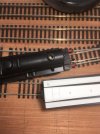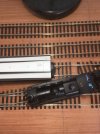Hi again, Steve
Your earlier post had me doubting myself, so I conducted some further tests just to ease my mind.
I selected a Dean Goods (this will be the mainstay of the line along with a recently purchased Dukedog to which I still need to fit the chip, and which is of similar dimensions) along with my trusty 8F with it’s longer length over buffers for a more stringent test (the protruding valve gear adds a further element of difficulty). The chosen item of stock was the Hornby clerestory with its wide body and steps (it won’t see service on the layout).
Then I commenced testing around critical points including both ends of run round, the siding adjacent to runaround and the siding furthermost from the platform at the point where the line serving the head shunt lies adjacent.
Terminus end of runaround with coach stationary two inches from diverging end of point:
View attachment 177615
Same again, this time at fiddle yard end of runround:
View attachment 177623
Dean on runround with coach parked in adjacent siding at closest point:
View attachment 177614
The Dean at its closest point to coach parked on furthest siding within two inches of diverging rails:
View attachment 177618
And now the 8F at same points:
View attachment 177619View attachment 177620View attachment 177621
As you can see, for some reason the 8F requires the coach to be a further quarter of an inch from the diverging end of the fiddle yard runround, but with a total of 27” to play with, this should still leave enough room for a B set and a covered van consist at the platform. In addition, the loading dock siding is 21” in length which leaves also sufficient room for stock.
Phew!
jonte
Edit: apologies for mix up and not posting ‘full’ the last two photos, but for certain reasons, I had to use my phone to post which is difficult for me to navigate. Jon.

 ). Only joking Mike!
). Only joking Mike!


 ) 009 gauge project. The recent discourse and revelations about anodised aluminium were indeed news to me. I bought mine some years back from B&Q - albeit it was of smaller dimensions than yours but that should not affect the issue. I never experienced any electrical trouble in operation - the cassettes were used on an earlier layout first and survived an exhibition without any operational problems. I can only assume they were not of the anodised type - undoubtedly more luck of the devil
) 009 gauge project. The recent discourse and revelations about anodised aluminium were indeed news to me. I bought mine some years back from B&Q - albeit it was of smaller dimensions than yours but that should not affect the issue. I never experienced any electrical trouble in operation - the cassettes were used on an earlier layout first and survived an exhibition without any operational problems. I can only assume they were not of the anodised type - undoubtedly more luck of the devil  !
!








 The info as described was helpful in as much as it encouraged me query this with the supplier, to avoid any potential pitfalls which, knowing my luck, would have proved inevitable
The info as described was helpful in as much as it encouraged me query this with the supplier, to avoid any potential pitfalls which, knowing my luck, would have proved inevitable











